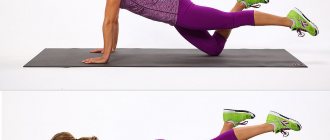Follow these tips to properly perform an upper body strength exercise.
• You can read about 5 strength exercises for your workouts here.
Most people say that the difference between chin-ups and strict pull-ups is where your hands are facing. (When doing pull-ups to the chin, the arms are turned with the palms inward, while in the tight pull-up, the palms are turned outward.)
But we think differently: the very term “chin-up” just means that when performing this exercise, all you need to do is touch the bar with your chin.
This is not nearly enough.
To get the most out of the exercise (and the reps that can count), we recommend pulling up until your chest touches the bar. That's why we call them "strict pull-ups", regardless of the position of your hands on the bar.
Let's look at the pull-up technique. There is a definite difference between kipping (where you use momentum for more reps) and hanging pull-ups, without swinging, until your chest touches the bar. This article is about the latter.
Kipping pull-ups are definitely good if you're competing for reps. But if you need to develop a big, powerful back, there's no substitute for strict pull-ups.
To do a proper strict pull-up, start by gripping the bar with your arms completely straight at the elbows. This is called the hanging position. Without swinging your torso to create momentum, pull yourself up until your chest touches the bar and your elbows are level with the center of your torso.
Don't be lazy and don't let gravity pull you down. Returning to the starting position is where the great value in building muscle and strength lies. Slowly return to the hanging position. Repeat.
If you do pull-ups the way I just described, 20 reps in a row will be enough to achieve your goal. Most guys won't do that much, unfortunately. If you do 20 reps, it will be a game changer for your upper body strength. Whether your hands are palms in or palms out on each rep doesn't really matter for the ultimate 20-pull-up circuit, so feel free to use both grips in equal amounts.
Here's how you can do 20 pull-ups.
Pull yourself up.
If you want to be good at pull-ups, do more pull-ups. Sounds too simple to be effective, doesn't it?
Many people want to find some “magic” exercise that will allow them to do better pull-ups, but it doesn’t work that way.
Here's the thing: People often do lat pulldowns (a machine that mimics the movement of a pull-up) thinking it will improve their pull-up skills. But this won't happen. You need something really worthwhile.
I understand that some of you are only able to do one good pull-up. So be it - but do one pull-up several times. Spreading these small sets in your routine - one pull-up between sets of various other exercises in your workout program for the day - is a good way to improve it.
Aim for 25-50 strict pull-ups three times a week (25 if you're a beginner). If you don't go to the gym, set up a pull-up bar at home and do a couple of pull-ups every time you pass by.
If you can already do five pull-ups, do as many sets of two or three reps as you need, without being shy about your maximum, until you reach 50 pull-ups in one workout.
The point is in quantity—by counting complete repetitions, the number will increase over time.
Forums
We are sure that many were looking forward to today's information post without even realizing it. This is because the topic of the issue was the issue of increasing the number of pull-ups on the horizontal bar. I’ll say right away that there are no secrets in this matter, but that’s the whole point!
IMPORTANT!!!:>
The information presented in this week's info posts is provided solely for informational purposes and to broaden your horizons (after all, we have an educational program). We recommend using it AFTER completing a 100-day workout.
If you read forums and VKontakte groups, you get the persistent feeling that 20 pull-ups is a real barrier separating those who really train seriously from everyone else. Indeed, many people can do 15-16 or even 18-19 pull-ups, but doing more than 20 repetitions becomes a problem for the vast majority.
Some good advice
Tip #1.
If you want to increase the maximum number of pull-ups, then do maximum pull-ups! After a certain point, it is very difficult to increase the number of pull-ups without directly doing maximum pull-ups, because doing maximum pull-ups presupposes a certain not only physical, but also psychological attitude.
When you pull yourself up to 20, there comes a turning point when you realize that you can do the maximum not in one breath, but hang a little and pull it out some more. That is, not only the current strength is used, but also some strength endurance. You just need to understand and use this, and not immediately jump off the horizontal bar as soon as you run out of strength, although many make this mistake.
Tip #2.
Don't set limits for yourself, or deliberately overestimate them. Sprinters never aim to stop at the finish line, because then they will start to slow down prematurely and lose speed. Same logic here! Want to do 20 pull-ups? Set a goal of 25 or 30, you may not reach it, but you can definitely get over 20!
Tip #3.
Always do pull-ups clean! There is no need to try to help yourself with inertia and kick your legs; pull-ups are a strength exercise. Have you pulled yourself up to the max? Gather your will and pull out at least one more repetition! Or better yet, 2! You must reach up while you have the strength. Are you out of strength? Pull yourself up as far as you can and hold at this point, then descend.
Three Quantity Training Methods
In general, we highlight 3 methods that can lead you to your goal of increasing the number of pull-ups and breaking the 20-rep mark. They are all tested by us personally, and they really work. With the first method we went from 5 to 15, with the second from 15 to 25, with the third from 25 to 35.
Method ONE.
The main idea of this method is to reduce the rest time between sets to a minimum (45-60 seconds), while still performing sets to the maximum.
Start with warm-up approaches and work your way up, and when you can’t raise the bar anymore, then do it to the maximum. The amount here is generally individual and depends on your level, but the point is to try to increase the number of repetitions in each approach from workout to workout. If your maximum was less than 10, then focus on 50 pull-ups in total in all approaches. This is a random number, just to give you a guide at the start. It is very important to stretch all the repetitions to the very end. You should get off the horizontal bar when you can no longer pull yourself up at all (that is, you even pulled yourself up halfway and that’s it, it doesn’t go any further). In general, do it to failure.
Method TWO.
It comes down to setting aside a day once a week on which you will push yourself to the max and try to beat your records. There is no need to immediately try to do the maximum on cold muscles; as practice shows, it is better to do 1-2 warm-up approaches, and only then flex. This way the result will be better, and the likelihood of injury will be less. And there should really be a lot of approaches to the maximum. For example, we did 10 approaches per workout.
It should be noted that this method is NOT SUITABLE for training outside in the cold season, because it requires a long rest (10-15 minutes) between approaches, and during this time your muscles will cool down and efficiency will drop significantly.
Method THIRD (method of 5 approaches).
When you want to add reps to a challenging exercise like pull-ups (although this method works for any exercise), you need to understand that even increasing 1 rep with a maximum of 20 is an immediate jump of 5%! It's not even a jump, it's a leap through the Grand Canyon. Well, what to do if 1 is the minimum possible increase in the amount when training with your own weight? We can’t throw on half a kilo, like with iron?
Can! The essence of this method is precisely to reduce the size of the minimum step. This is done by changing your attitude to the maximum and dividing it into 5 approaches. Hence the name of the method. Instead of counting your max for 1 rep, count your max for 5 reps with 4-3-2-1 minutes of rest between sets respectively. Let's say you thought that your maximum was 20 repetitions (if you do 1 set), and if you do 5, then your maximum will be, for example, 60 repetitions (20-15-10-5-5). And in the next workout you will try to add at least 1 repetition in each approach. In this case, 1 repetition is no longer 5%, but only 1.7%, and if we are talking about the last approach, then even less, in fact.
Why are there 5 approaches? We took this number from the bullshit, with the same success there could have been 3 or 7, it’s all individual. We like the number 5, it's beautiful, so 5 approaches. Try this method on yourself, and you will be surprised that in just a month of training you can raise your maximum in the first approach!
How to trick your brain?
As we said earlier, there is more than just a physical component to doing pull-ups more than 20 times. Previously, we also thought that 20 was really a lot and hard, so we easily did 10-15 pull-ups, but then the strength seemed to disappear and each subsequent pull-up was wildly difficult (a familiar feeling, right?). So here are a couple of simple techniques that will change the situation:
Reverse counting order.
How do we usually count when we do pull-ups? 1,2,3 etc. As a result, with each subsequent repetition, the number we call becomes larger and larger, and subconsciously this puts pressure on us. As a result, we approach the 20th simply exhausted (after 17, 18 and 19). Try counting the other way around! Start with 20 and decrease the number with each repetition, i.e. 20, 19, 18, 17, etc. As a result, at the very end you will call out small numbers (5,4,3,2,1) and thus it will be easier for you to pull yourself up!
Dividing a whole into parts.
20 pull-ups is not that little, while almost everyone can do 5 or 10 reps. Use the perceptual effect and divide 20 by 4 times 5 or 2 times 10, counting within the given interval each time. The effect will be the same as in the previous version - it will become a little easier to pull yourself up!
We would like to say a few final words. Many people say that you should definitely use weights to increase the number of pull-ups, or the help of a partner to achieve repetitions. We didn't use either one. We learned how to do more than 30 pull-ups purely with our own weight. To do a lot of pull-ups you need to have a good grip (because you will need to hang a lot), strong and resilient muscles (arms, back), well, the mood is also important, because only by believing in your strength can you achieve results!
100-day workout - Contents
Master negative pull-ups.
Some guys can't even do a single pull-up. The best way to start is to practice slowly lowering yourself to the starting hanging position.
Grab the bar and hold yourself as you would in the top pull-up position. Lower yourself slowly, returning to the hanging position should take 4-5 seconds. Do such complexes every workout.
You'll soon be able to do your first pull-up.
Guys who have already mastered pull-ups will also find something valuable in negative pull-ups. Even if you're almost able to do all 20 pull-ups, during each workout, do one set of fewer pull-ups, but returning to the hanging position as slowly as possible.
Trust me, it works.
How can a child learn to do pull-ups on a home horizontal bar?
If you want your child to join you in playing your favorite sport and also learn to do pull-ups, then this is a very laudable desire. If you don’t overload a fragile body with training, but evenly distribute the load across different muscle groups, this will help your son or daughter learn to pull themselves up and grow up strong and healthy.
It is important to know that children should begin learning to do pull-ups on the horizontal bar no earlier than they reach the age of ten to twelve years. At this time, the child’s body will already be developed enough to learn how to pull himself up and such exercises will not harm him.
You can start with a hand expander, with the help of which a child can train tenacity, which will protect him from falling from the horizontal bar. And it’s best to start classes on a wall bars, so that your son or daughter can, while trying to learn how to do pull-ups, help themselves at first by holding on with their feet. In general, a training program for an adult is quite suitable for a teenager of ten to twelve years old. The main thing is not to force the child to do too many pull-ups on the horizontal bar, so that this does not subsequently affect his health.
Work the muscles responsible for pull-ups.
Exercises that work the same muscles as pull-ups will help you get more reps.
The exercise I recommend for anyone who wants to do more pull-ups is the horizontal pull-up.
Place a barbell at about waist level on a squat rack or Smith machine (this exercise is probably the only benefit of a Smith machine). Hang from the bar with your arms shoulder-width apart, keeping them completely straight, in a position directly above your shoulders, with your heels touching the floor. Your body should be completely straight from your ankles to your head.
Squeeze your shoulder blades and continue to pull yourself toward the bar until your chest touches it. Freeze in this position, then return to the starting position. Remember to maintain an upright position while performing the exercise. Do at least three heavy or failure sets each workout.
A few more exercises to add to your routine: bent-over rows, wide-grip deadlifts, and T-bar rows.










